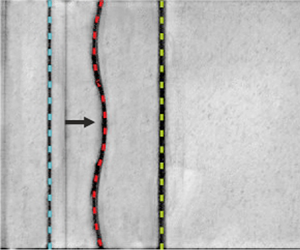Crossref Citations
This article has been cited by the following publications. This list is generated based on data provided by
Crossref.
Liang, Yu
2022.
The phase effect on the Richtmyer–Meshkov instability of a fluid layer.
Physics of Fluids,
Vol. 34,
Issue. 3,
Liang, Yu
2022.
Fundamental Studies of Shock-Driven Hydrodynamic Instabilities.
p.
103.
Sterbentz, Dane M.
Jekel, Charles F.
White, Daniel A.
Aubry, Sylvie
Lorenzana, Hector E.
and
Belof, Jonathan L.
2022.
Design optimization for Richtmyer–Meshkov instability suppression at shock-compressed material interfaces.
Physics of Fluids,
Vol. 34,
Issue. 8,
Liang, Yu
and
Luo, Xisheng
2022.
On shock-induced evolution of a gas layer with two fast/slow interfaces.
Journal of Fluid Mechanics,
Vol. 939,
Issue. ,
Wang, Yang
and
Dong, Gang
2022.
A numerical study of shock-interface interaction and prediction of the mixing zone growth in inhomogeneous medium.
Acta Mechanica Sinica,
Vol. 38,
Issue. 12,
Liang, Yu
and
Luo, Xisheng
2022.
On shock-induced light-fluid-layer evolution.
Journal of Fluid Mechanics,
Vol. 933,
Issue. ,
Liang, Yu
and
Luo, Xisheng
2023.
Hydrodynamic instabilities of two successive slow/fast interfaces induced by a weak shock.
Journal of Fluid Mechanics,
Vol. 955,
Issue. ,
Zhang, Duo
Ding, Juchun
Li, Ming
Zou, Liyong
and
Luo, Xisheng
2023.
Effects of reverberating waves and interface coupling on a divergent Richtmyer–Meshkov instability.
Journal of Fluid Mechanics,
Vol. 975,
Issue. ,
Singh, Satyvir
and
Torrilhon, Manuel
2023.
On the shock-driven hydrodynamic instability in square and rectangular light gas bubbles: A comparative study from numerical simulations.
Physics of Fluids,
Vol. 35,
Issue. 1,
Liang, Yu
and
Luo, Xisheng
2023.
Review on hydrodynamic instabilities of a shocked gas layer.
Science China Physics, Mechanics & Astronomy,
Vol. 66,
Issue. 10,
Zhang, Duo
Ding, Juchun
Si, Ting
and
Luo, Xisheng
2023.
Divergent Richtmyer–Meshkov instability on a heavy gas layer.
Journal of Fluid Mechanics,
Vol. 959,
Issue. ,
West, Scott R.
Sadler, James D.
Powell, Philip D.
and
Zhou, Ye
2024.
Shock-driven three-fluid mixing with various chevron interface configurations.
Physics of Fluids,
Vol. 36,
Issue. 10,
Sadler, James D.
Powell, Philip D.
Schalles, Mark
Louie, Carlton
Jacobs, Jeffrey W.
and
Zhou, Ye
2024.
Simulations of three-layer Richtmyer–Meshkov mixing in a shock tube.
Physics of Fluids,
Vol. 36,
Issue. 1,
Schalles, M.
Louie, C.
Peabody, K.
Sadler, J.
Zhou, Y.
and
Jacobs, J.
2024.
Shock tube experiments on the three-layer Richtmyer–Meshkov instability.
Physics of Fluids,
Vol. 36,
Issue. 1,
Li, Xin
Hao, Jiaao
Wen, Chih-Yung
and
Fan, E
2024.
Effects of Mach and Atwood numbers on the shock-induced evolution of a double-layer gas cylinder.
Physics of Fluids,
Vol. 36,
Issue. 2,




